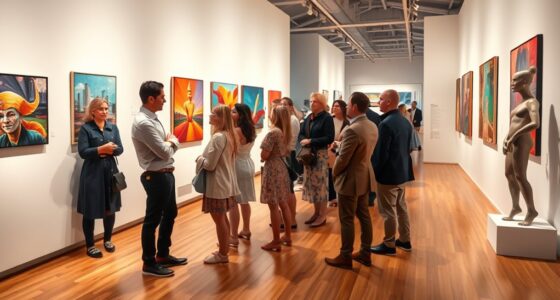The psychology behind collecting art reveals that it’s driven by emotional expression, personal identity, and social status. You seek artworks that resonate with your feelings, reflect your values, or boost your image. The thrill of discovering hidden gems and the satisfaction of building a meaningful collection also motivate you. These desires connect to deeper needs for self-expression, achievement, and belonging. Exploring these motivations further can help you understand what fuels your passion for art collecting.
Key Takeaways
- Art collecting activates reward mechanisms in the brain, releasing dopamine and reinforcing feelings of achievement and satisfaction.
- Emotional and personal connections to artworks serve as outlets for healing and self-expression, motivating continued collection.
- Collecting reflects individual identity, cultural background, and memories, creating a meaningful narrative that deepens emotional attachment.
- The thrill of discovery and uncovering rare or significant works stimulates excitement and a sense of mastery.
- Social status and cultural recognition influence motivations, with collection serving as a symbol of prestige and personal values.
The Emotional Appeal of Art Collecting
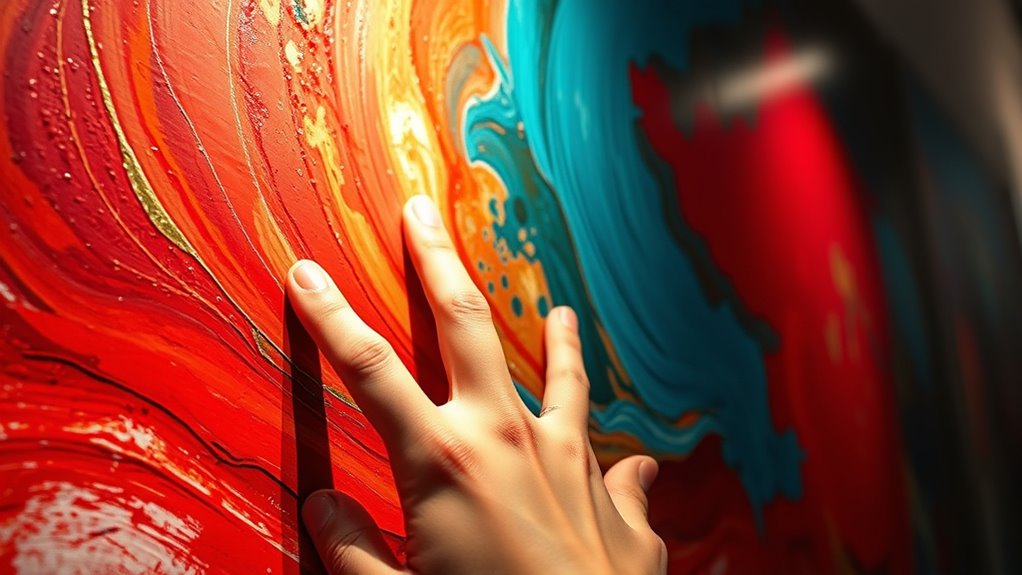
Have you ever wondered why people feel so drawn to collecting art? It’s often because art provides a powerful outlet for emotional release and healing, much like art therapy. When you collect art, you’re engaging in creative expression that helps process feelings and experiences. Each piece you choose can evoke memories, inspire joy, or offer comfort during tough times. This emotional connection fuels your passion for collecting, making it more than just a hobby—it’s a way to connect with your inner world. Art becomes a mirror of your emotions, offering a sense of fulfillment and understanding. The emotional appeal of collecting art taps into your desire for self-expression and healing, making it a deeply personal and rewarding experience.
How Collecting Shapes Personal Identity

Collecting art actively shapes your personal identity by reflecting your values, tastes, and experiences. As you choose specific pieces, you express what resonates with you, revealing your worldview and interests. Art as therapy plays a role here, helping you process emotions and find meaning through your collection. The rituals you develop around collecting—like visiting galleries or carefully curating your acquisitions—reinforce your sense of self and create a personal narrative. These rituals provide structure and purpose, making collection a reflection of your identity. Over time, your collection becomes a mirror of who you are, showcasing your journey, beliefs, and aesthetic preferences. Additionally, exploring different art styles and genres can expand your understanding and appreciation, further shaping your identity through diverse genres. In this way, collecting isn’t just about art; it’s a powerful act of self-expression and identity formation.
The Role of Social Status in Art Acquisition

Social status often influences how and why people acquire art, serving as a symbol of wealth, taste, and social positioning. When you collect art, it becomes a status symbol, signaling your place in society. This desire to display wealth often drives you to acquire high-profile pieces that elevate your social standing. The table below illustrates different motivations behind art collection and their connection to social status:
| Motivation | Example | Impact on Status |
|---|---|---|
| Wealth display | Buying expensive art | Signals financial success |
| Status symbols | Owning renowned artists’ works | Enhances social image |
| Social validation | Collecting trendy pieces | Gains peer approval |
| Cultural capital | Supporting museums, galleries | Demonstrates sophistication |
| Prestige building | Exhibiting at shows | Reinforces elite status |
Additionally, understanding the role of art investment can further enhance one’s social reputation by showcasing both cultural appreciation and financial acumen.
The Thrill of Discovery and the Hunt for Masterpieces
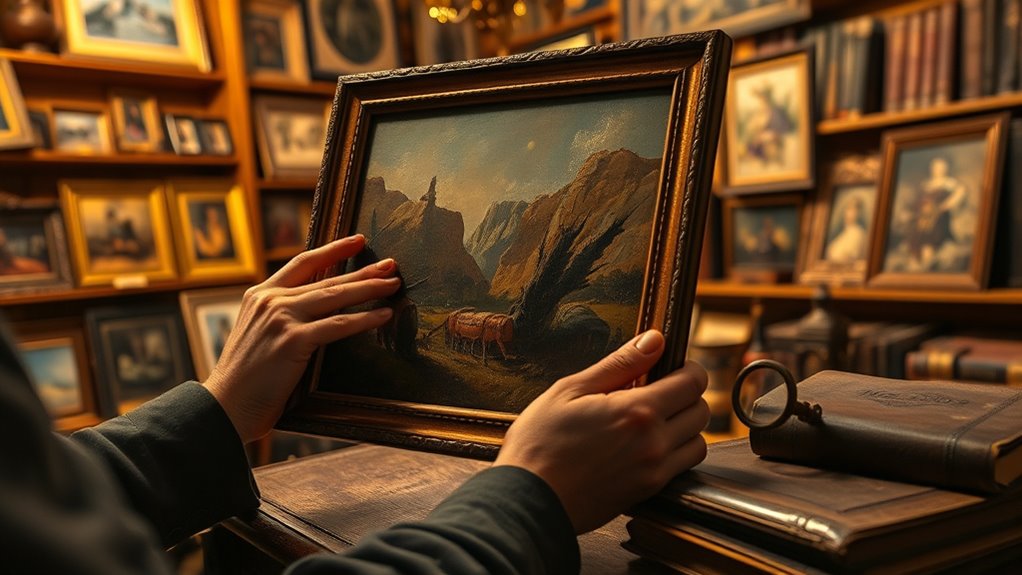
The thrill of discovery fuels many art collectors’ passions, turning the search for masterpieces into an exhilarating pursuit. When you uncover a piece with rich historical significance, it feels like connecting with a past moment alive again. You’re driven by the possibility of finding artworks that challenge artistic innovation, pushing boundaries and redefining genres. The hunt often leads you to hidden gems, rare works, or lesser-known artists whose contributions shaped art history. Each discovery heightens your excitement and deepens your appreciation for the evolution of artistic expression. The process isn’t just about acquiring art; it’s about experiencing the journey of unearthing pieces that tell compelling stories and embody revolutionary ideas. The pursuit keeps your collection vibrant and meaningful, especially when considering how color accuracy influences the visual impact of artworks, making each piece more vivid and true to the artist’s original intent.
Collecting as a Form of Self-Expression
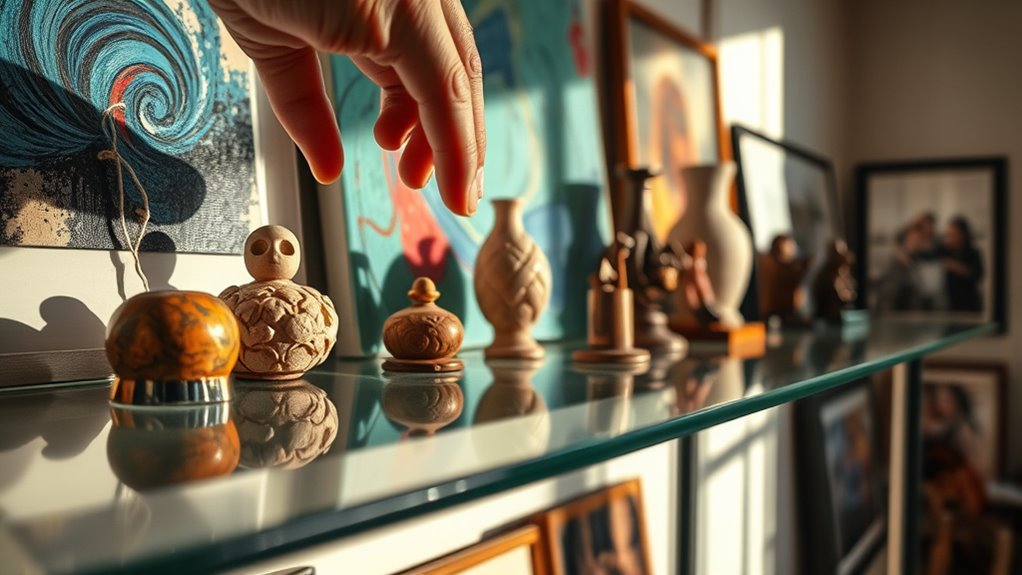
Your collection often reflects who you are and what matters most to you. Each piece can create an emotional bond and reveal your personal story. By choosing specific artworks, you showcase a unique style that expresses your identity. Additionally, understanding the trustworthiness of art sources can help ensure your collection remains authentic and valuable over time.
Personal Identity Reflection
Collecting art often serves as a powerful way to express your personal identity, revealing what resonates with you on a deeper level. Your art collection becomes a reflection of your values, experiences, and evolving tastes, making it a lifelong journey of self-discovery. Through this process, you engage in personal growth, using collecting as a tool to explore different perspectives and ideas. Each piece you choose represents a facet of who you are or aspire to be, shaping your sense of self over time. As your collection grows, so does your understanding of yourself, turning collecting into an ongoing dialogue between your inner world and external expression. Ultimately, your art collection becomes a mirror of your personal evolution. Incorporating personal identity reflection into your collection can deepen this connection, enriching your journey of self-expression.
Emotional Connection Significance
Because art evokes strong emotions, collecting becomes a deeply personal act of self-expression. When you select pieces, you seek emotional resonance that reflects your inner feelings and experiences. These artworks often hold sentimental value, turning them into symbols of important moments or relationships. Your choices reveal what resonates with you on a deeper level, making your collection a reflection of your emotional landscape. The connection you feel to certain pieces isn’t just about aesthetics; it’s about the stories, memories, and emotions they evoke. This emotional bond makes collecting meaningful, transforming it from a hobby into a form of personal storytelling. Ultimately, your collection becomes a visual representation of your inner world, shaped by the feelings and memories attached to each piece. Additionally, understanding the significance of emotional connection can help collectors develop a more intentional and fulfilling approach to their collections.
Unique Style Showcase
Expressing your personality through art collection transforms it into a powerful act of self-identity. You select pieces that reflect your taste, values, and emotions, showcasing your unique style. Artistic techniques like brushwork or mixed media reveal your appreciation for craftsmanship, while color symbolism communicates your mood or beliefs. Your collection becomes a visual narrative of who you are. To understand this deeper, consider the following:
| Artistic Techniques | Color Symbolism | Personal Expression |
|---|---|---|
| Brushwork | Red for passion | Bold choices |
| Collage | Blue for calm | Emotional depth |
| Impasto | Green for growth | Growth and renewal |
| Minimalism | Black for power | Simplicity and strength |
Additionally, the use of color symbolism can evoke specific emotions, aligning your collection with your inner feelings and personality.
Psychological Rewards and the Sense of Achievement
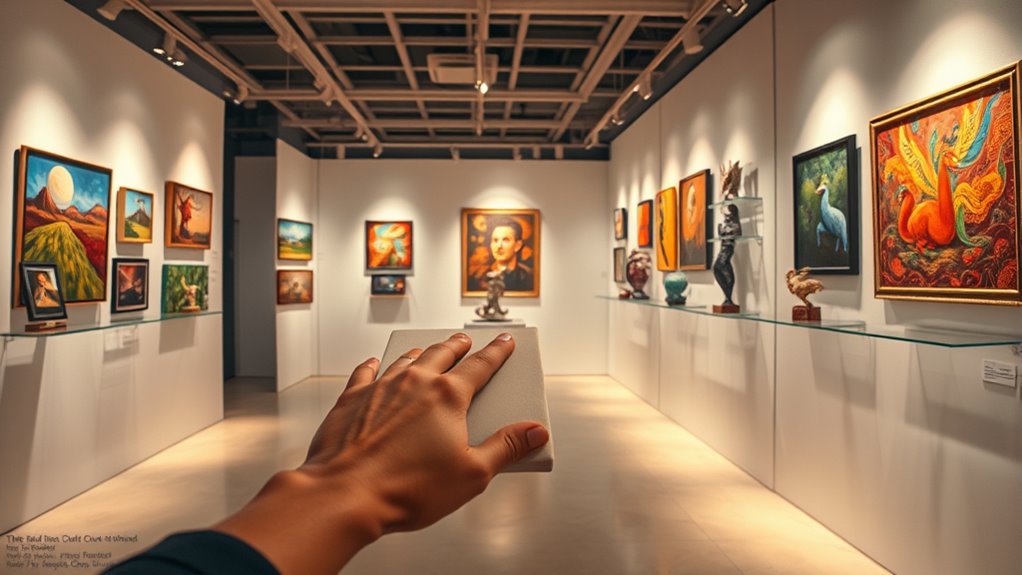
Engaging in art collecting provides a powerful sense of achievement that fuels your motivation to continue. This feeling taps into motivational psychology, reinforcing your desire to expand your collection. When you acquire a rare or meaningful piece, your brain activates reward mechanisms, releasing dopamine and creating a sense of pleasure. These psychological rewards strengthen your connection to collecting, making each successful acquisition more satisfying. The sense of progress and mastery boosts your confidence, encouraging you to pursue more challenging or valuable artworks. As you see your collection grow, you experience tangible proof of your dedication and skill. This cycle of achievement and reward keeps you inspired, turning art collecting into a deeply fulfilling activity driven by positive reinforcement. Additionally, recognizing the benefits of curiosity can enhance your appreciation for art, encouraging you to explore diverse styles and artists that enrich your collection.
The Influence of Cultural and Personal Memories
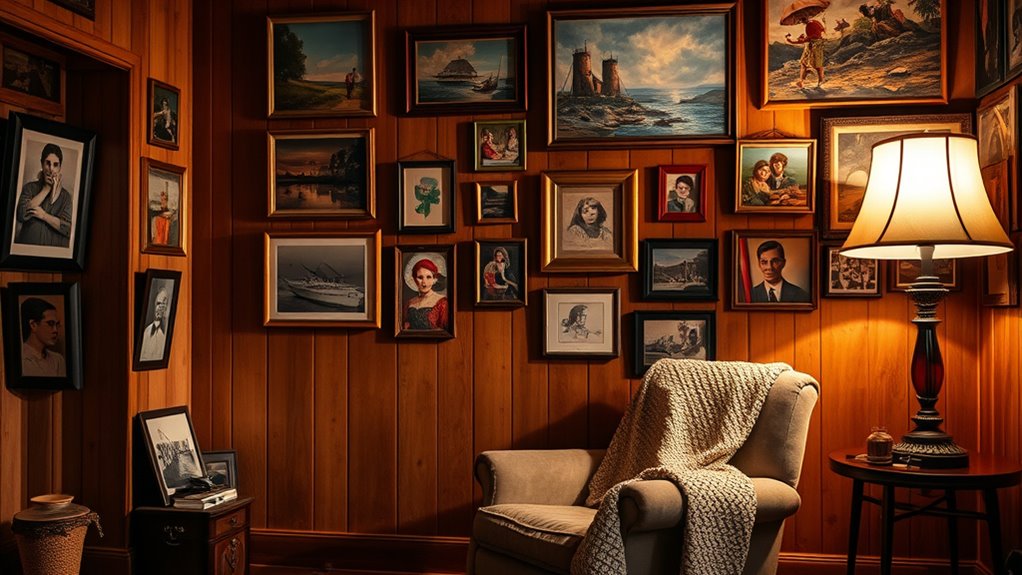
Your memories shape the art you choose, connecting you to feelings of nostalgia and your identity. Cultural heritage often drives your collection, reflecting your background and values. Personal memories act as triggers, making certain pieces more meaningful and deeply significant to you. Additionally, the emotional appeal of well-selected art can enhance your overall well-being and sense of belonging, especially when it resonates with your cultural background.
Nostalgia and Identity
Nostalgia often shapes the way people select and display art because it connects them to meaningful moments from their past. When you choose certain pieces, you’re not just adding decor — you’re reinforcing your identity and personal history. This emotional connection influences art market dynamics, as collectors value works that evoke specific memories or sentiments. You might seek pieces that remind you of your childhood or a significant milestone, making them more than mere investments. Additionally, your desire to preserve these emotional connections impacts art conservation efforts, ensuring that the art retains its sentimental value over time. Your choices reflect your story, and understanding this can deepen your appreciation of how personal and cultural memories shape art collecting. The influence of cultural heritage also guides collectors in selecting pieces that resonate with their ancestral traditions and community identity.
Cultural Heritage Significance
Cultural and personal memories deeply influence how you assign significance to art within your collection. These memories connect you to your roots, shaping your sense of cultural preservation and heritage significance. When you acquire art linked to your background, you’re not just collecting objects; you’re safeguarding stories and traditions. Understanding the safety features of your collection items can also ensure their preservation over time, protecting your cultural heritage.
- Art becomes a symbol of your cultural identity, reinforcing community ties.
- It helps preserve heritage significance, passing traditions to future generations.
- These pieces serve as tangible links to your history, fostering pride and continuity.
Personal Memory Triggers
Personal memories often act as powerful triggers that deepen your connection to the art you collect. When you see a piece that sparks memory associations, it evokes emotions linked to specific moments, people, or places. These connections give the artwork sentimental value beyond its aesthetic appeal. For example, a painting from a childhood trip or a sculpture gifted by a loved one becomes more meaningful because it reminds you of those experiences. Your personal history shapes your preferences, making certain artworks irreplaceable. This emotional attachment enhances your collection’s significance, turning it into a reflection of your life’s journey. Recognizing the importance of creative storytelling can further enrich how you interpret and value your collection. In this way, personal memory triggers transform art from mere objects into cherished treasures that embody your unique story.
Common Motivations and Underlying Desires
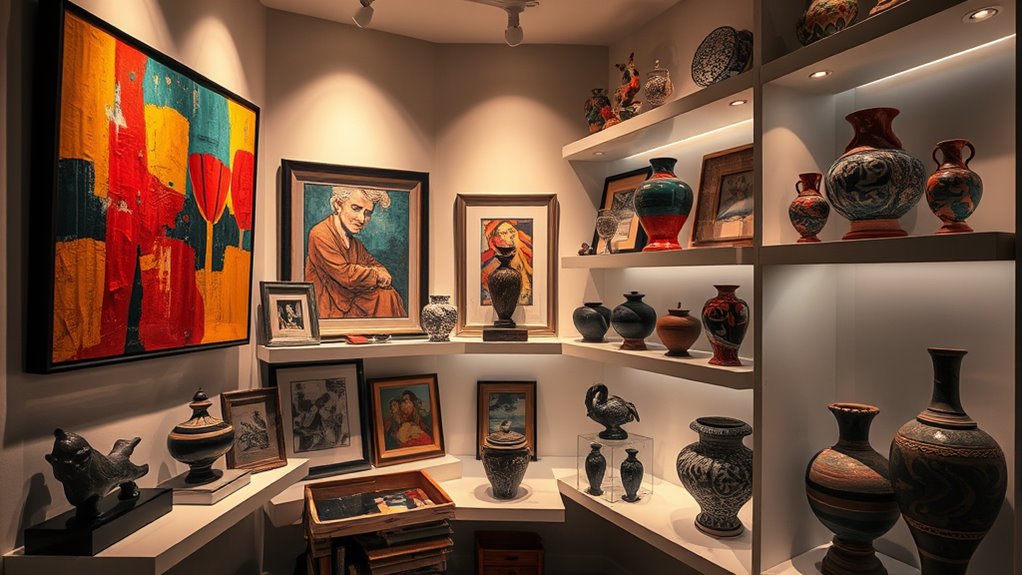
People are often driven to collect art by a desire to express their collector identity and showcase their aesthetic appreciation. This motivation helps you feel connected to your unique tastes and personal story. Your collection reflects who you are and what you value. To deepen this understanding, consider these underlying desires:
- Self-Expression – Using art to communicate your personality and beliefs.
- Status and Recognition – Gaining admiration from peers and affirming your social position.
- Aesthetic Fulfillment – Experiencing joy through the beauty and harmony of your collection.
These motivations guide your choices and reinforce your emotional connection to art, making collecting a meaningful extension of yourself.
Frequently Asked Questions
How Does Art Collecting Impact Mental Health Over Time?
Art collecting can positively impact your mental health over time by providing emotional fulfillment and cognitive stimulation. As you seek out and acquire new pieces, you engage your mind actively, which keeps you mentally sharp. The emotional connection to your collection offers comfort and joy, reducing stress. Over time, this hobby fosters a sense of purpose and achievement, boosting your overall well-being and resilience.
Can Collecting Art Alleviate Feelings of Loneliness or Isolation?
Imagine loneliness as a silent shadow, and collecting art as a vibrant bridge to connection. When you actively seek out meaningful pieces, you foster emotional bonds—not just with the artwork but with a community of fellow enthusiasts. This social engagement can ease feelings of isolation, making you feel part of something larger. Art becomes more than decoration; it’s a tool to nurture emotional connection and combat loneliness over time.
What Subconscious Biases Influence Art Acquisition Choices?
When you choose art, subconscious biases like impostor syndrome and aesthetic bias shape your decisions. You might doubt your taste or feel unworthy of certain pieces, leading you to select art that reinforces your self-image. Aesthetic bias causes you to favor styles or artists that align with your preferences or social expectations. Recognizing these influences helps you make more authentic choices, ensuring your collection reflects your true appreciation rather than subconscious pressures.
How Does Art Collecting Affect Decision-Making and Risk-Taking Behavior?
Art collecting can totally transform your decision-making, making you an impulsive decision ninja. You develop emotional attachment, which clouds your judgment and pushes you toward risky choices. This passion fuels your desire to acquire that perfect piece, often leading to decisions driven more by emotion than logic. As a collector, your risk-taking skyrockets, and every purchase becomes an exciting leap into the unknown, shaping your behaviors in powerful, unpredictable ways.
Are There Common Psychological Traits Among Successful Art Collectors?
You often find that successful art collectors share psychological traits like strong emotional attachment to their pieces and a deep sense of cultural identity. These traits drive their passion, dedication, and persistence in acquiring art. You may notice that such individuals prioritize personal connection over monetary value, fostering a genuine appreciation. This emotional attachment helps build a meaningful collection, and their cultural identity influences their choices, making their collections uniquely reflective of their background and values.
Conclusion
So, next time you’re nervously eyeing that rare piece, remember—you’re not just building a collection, you’re crafting a gallery of your ego, status, and secret obsessions. It’s like turning your living room into a museum of your personal quirks, with a splash of societal approval. After all, who needs therapy when you can chase the thrill of the perfect masterpiece—just be prepared for the day your art collection outgrows your walls and becomes your new personality.





